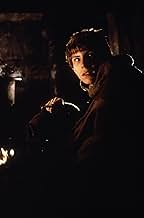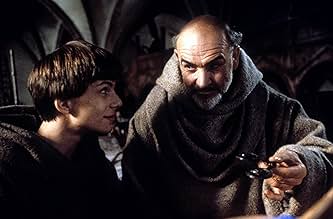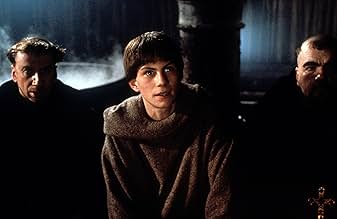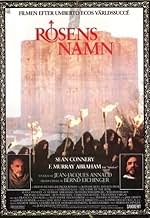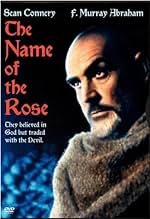Un monje inconformista investiga una serie de misteriosas muertes en una abadía aislada.Un monje inconformista investiga una serie de misteriosas muertes en una abadía aislada.Un monje inconformista investiga una serie de misteriosas muertes en una abadía aislada.
- Ganó 2 premios BAFTA
- 17 premios y 6 nominaciones en total
Donald O'Brien
- Pietro d'Assisi
- (as Donal O'Brian)
Argumento
¿Sabías que...?
- CuriosidadesSean Connery's career was at such a low point when he read for the role that Columbia Pictures refused to finance the movie when Jean-Jacques Annaud cast him as William von Baskerville.
- PifiasThe secret message on the parchment is exposed three times. The translator heated it to reveal the location of the library, William of Baskerville heated it again when he was in the scriptorium and yet again to show the others the message. When a message is written in lemon juice, heating it will cause it to become exposed because the sugar in the juice is caramelized and thus would not disappear again.
- Citas
William of Baskerville: But what is so alarming about laughter?
Jorge de Burgos: Laughter kills fear, and without fear there can be no faith, because without fear of the Devil there is no more need of God.
- Créditos adicionalesThe opening credits read - A palimpsest of Umberto Eco's Novel The Name of the Rose
- Versiones alternativasCertain prints of the movie have the sex scene between Adso and The Girl removed in order to comply with local laws.
Reseña destacada
A number of people have commented on the similarity of this film, and the Novel by Umberto Eco, to the DaVinci Code. For those who were not born then, The Name of the Rose was published in 1980, thus predating DaVinci by about 20 or more years. I must admit that I found DaVinci to be a mass market popularization of Eco's theme, in short a "rip off". Still, it may be the popularity of Brown's novel which has resulted in Name of the Rose being brought back in a DVD version, and for that I am truly thankful.
For a film which was not favorably reviewed by the critics, it is surprising how many reviewers 20 years later are giving it a 10. Either the film wore well or tastes have changed. I loved the film first time around and was delighted to find it on DVD. Certainly the screenplay had to deviate from the philosophizing of the book. It would have been almost unwatchably "talkie" had it not, and those of us who want to read the sermons/discussions can read the book. The film stands on it's own.
The most ominous feeling for me, living in the religious and politically free thinking 21st century, was the realization that the church had such a grip on every aspect of life and thinking in the middle ages, and that any perceived repudiation of accepted Church dogma was deemed heresy and punishable by torture and a horrible death. That one group of people should wield such power, and the length they would go to to hold on to that power is truly frightening. The rigid class structure where the nobility and church owned the land which the peasants worked, and supported those above them while being kept down by those above, was very well conveyed in the film. Life was short and hard, health was poor and the plague could return at any time, carrying off those who had not been carried off by the incessant wars. Not a pleasant age to live. The period of the film is set just prior to the reformation. It is hardly surprising that the teachings of the various religious orders began to be questioned.
For a film which was not favorably reviewed by the critics, it is surprising how many reviewers 20 years later are giving it a 10. Either the film wore well or tastes have changed. I loved the film first time around and was delighted to find it on DVD. Certainly the screenplay had to deviate from the philosophizing of the book. It would have been almost unwatchably "talkie" had it not, and those of us who want to read the sermons/discussions can read the book. The film stands on it's own.
The most ominous feeling for me, living in the religious and politically free thinking 21st century, was the realization that the church had such a grip on every aspect of life and thinking in the middle ages, and that any perceived repudiation of accepted Church dogma was deemed heresy and punishable by torture and a horrible death. That one group of people should wield such power, and the length they would go to to hold on to that power is truly frightening. The rigid class structure where the nobility and church owned the land which the peasants worked, and supported those above them while being kept down by those above, was very well conveyed in the film. Life was short and hard, health was poor and the plague could return at any time, carrying off those who had not been carried off by the incessant wars. Not a pleasant age to live. The period of the film is set just prior to the reformation. It is hardly surprising that the teachings of the various religious orders began to be questioned.
- emuir-1
- 12 mar 2005
- Enlace permanente
Selecciones populares
Inicia sesión para calificar y añadir a tu lista para recibir recomendaciones personalizadas
Detalles
- Fecha de lanzamiento
- Países de origen
- Idiomas
- Títulos en diferentes países
- El nom de la rosa
- Localizaciones del rodaje
- Kloster Eberbach, Eltville Am Rhein, Hessen, Alemania(interiors: monastery church)
- Empresas productoras
- Ver más compañías en los créditos en IMDbPro
Taquilla
- Presupuesto
- 30.000.000.000 ITL (estimación)
- Recaudación en Estados Unidos y Canadá
- 7.153.487 US$
- Fin de semana de estreno en EE. UU. y Canadá
- 494.571 US$
- 28 sept 1986
- Recaudación en todo el mundo
- 7.153.487 US$
- Duración2 horas 10 minutos
- Color
- Relación de aspecto
- 1.85 : 1
Contribuir a esta página
Sugerir un cambio o añadir el contenido que falta

Principal laguna de datos
What is the streaming release date of El nombre de la rosa (1986) in India?
Responde
